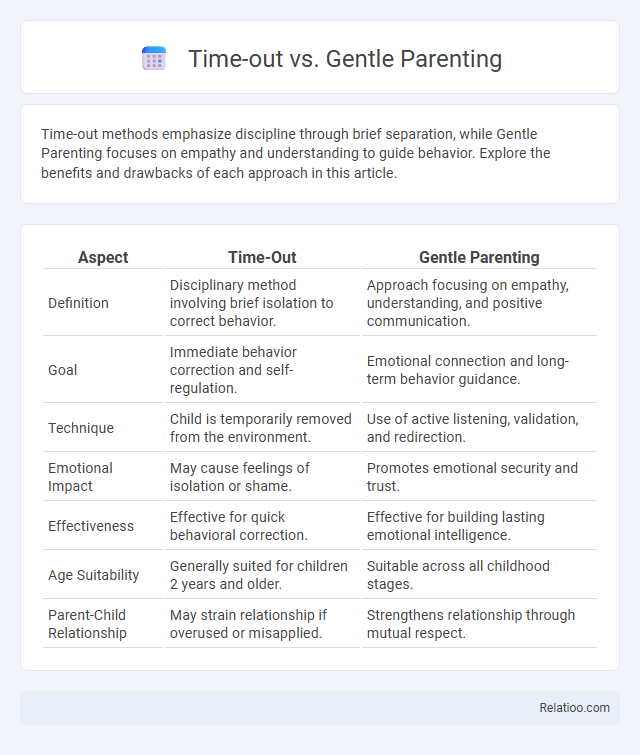Time-out methods emphasize discipline through brief separation, while Gentle Parenting focuses on empathy and understanding to guide behavior. Explore the benefits and drawbacks of each approach in this article.
Table of Comparison
| Aspect | Time-Out | Gentle Parenting |
|---|---|---|
| Definition | Disciplinary method involving brief isolation to correct behavior. | Approach focusing on empathy, understanding, and positive communication. |
| Goal | Immediate behavior correction and self-regulation. | Emotional connection and long-term behavior guidance. |
| Technique | Child is temporarily removed from the environment. | Use of active listening, validation, and redirection. |
| Emotional Impact | May cause feelings of isolation or shame. | Promotes emotional security and trust. |
| Effectiveness | Effective for quick behavioral correction. | Effective for building lasting emotional intelligence. |
| Age Suitability | Generally suited for children 2 years and older. | Suitable across all childhood stages. |
| Parent-Child Relationship | May strain relationship if overused or misapplied. | Strengthens relationship through mutual respect. |
Understanding Time-Out: Definition and Purpose
Time-out is a disciplinary technique used to temporarily remove a child from a situation to help them calm down and reflect on their behavior, promoting self-regulation and accountability. Gentle Parenting contrasts with time-out by emphasizing empathy, communication, and positive reinforcement rather than punishment, aiming to build trust and emotional understanding between parent and child. Understanding time-out requires recognizing its purpose as a structured pause that supports emotional control without causing fear, distinguishing it from harsher disciplinary methods.
What Is Gentle Parenting? Core Principles
Gentle Parenting is an empathetic approach focused on respect, understanding, and nurturing a child's emotional development rather than punitive discipline methods like time-outs. Core principles include fostering open communication, validating your child's feelings, and using positive reinforcement to guide behavior. You can build a trusting relationship by prioritizing empathy and connection over punishment, encouraging cooperation and emotional intelligence.
Historical Evolution of Parenting Strategies
The historical evolution of parenting strategies reveals a shift from traditional time-out methods, characterized by discipline and behavioral correction, towards gentle parenting, which emphasizes empathy, connection, and emotional development. Time-out approaches gained prominence in the mid-20th century as a structured behavioral management tool, while gentle parenting emerged more recently, influenced by attachment theory and child psychology research advocating for nurturing and responsive caregiving. This transition reflects broader societal changes prioritizing mental health, positive reinforcement, and developmentally appropriate discipline techniques.
Comparing Time-Out and Gentle Parenting Approaches
Time-out and gentle parenting represent two distinct disciplinary approaches; time-out emphasizes temporary removal to encourage self-regulation, whereas gentle parenting prioritizes empathy and communication to guide behavior. Time-out uses a structured period of isolation, often effective for immediate behavior correction, while gentle parenting fosters long-term emotional intelligence by addressing underlying feelings. Your choice depends on whether you prefer clear boundaries enforced through consequences or a nurturing strategy that builds trust and emotional connection.
Psychological Effects on Children: Time-Out vs Gentle Parenting
Time-out methods often focus on behavioral compliance but can increase feelings of isolation and anxiety in children, potentially impacting self-esteem and emotional regulation. Gentle parenting emphasizes empathy, emotional connection, and communication, promoting secure attachment and better long-term psychological resilience. Research indicates that gentle parenting techniques support healthier emotional development compared to traditional time-out approaches, reducing aggressive behavior and enhancing emotional intelligence.
Discipline vs Connection: Navigating Behavior Correction
Time-out emphasizes behavior correction through temporary separation, reinforcing discipline by setting clear boundaries and consequences. Gentle Parenting prioritizes emotional connection and understanding, fostering cooperation and self-regulation by addressing the child's feelings and needs. Your approach to discipline vs connection will determine whether you use time-outs to enforce rules or gentle parenting to build trust and long-term behavioral change.
Common Misconceptions about Time-Out and Gentle Parenting
Time-out is often misunderstood as a punitive or harsh discipline method, but its true purpose is to provide children a moment to calm down and reflect, promoting self-regulation rather than punishment. Gentle parenting is commonly mistaken for permissiveness or lack of boundaries, whereas it actually emphasizes empathy, respect, and clear, consistent limits to nurture emotional intelligence. Both approaches, when applied correctly, aim to support healthy child development but require careful implementation to avoid these widespread misconceptions.
Expert Opinions: Research and Studies
Research on time-out versus gentle parenting reveals varied expert opinions, with studies indicating that time-out methods can effectively reduce disruptive behavior when used consistently and calmly. Gentle parenting emphasizes empathetic communication and emotional validation, supported by research highlighting its benefits in fostering secure attachment and long-term emotional regulation. Recent meta-analyses suggest combining time-out with gentle strategies may optimize behavioral outcomes while promoting child psychological well-being.
Practical Tips for Parents: Choosing an Approach
Time-out involves temporarily removing a child from a situation to calm down, effective for immediate behavior correction, while gentle parenting emphasizes empathy and positive reinforcement to build long-term emotional skills. Parents choosing between these approaches should consider their child's temperament, consistency in application, and the family's communication style to ensure the chosen method supports emotional development. Practical tips include setting clear boundaries with time-outs, using calm explanations during gentle parenting, and combining both approaches flexibly based on specific situations.
Long-Term Outcomes: Building Positive Parent-Child Relationships
Gentle parenting emphasizes empathy and open communication, fostering long-term emotional security and trust between parent and child. Time-out methods can provide immediate behavior correction but may risk undermining the parent-child bond if overused or perceived as punitive. Combining time-out with gentle parenting principles supports positive discipline while nurturing healthy, lasting relationships rooted in mutual respect and understanding.

Infographic: Time-out vs Gentle Parenting
 relatioo.com
relatioo.com